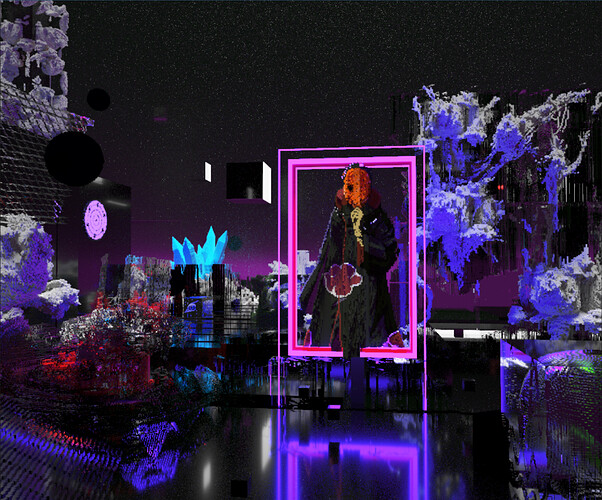There’s a very large community of artists in the VOXEL art community; professional Voxel artists are selling their PNG files of their voxel art for over 2 ETH each. Unfortunately, These NFT’s won’t be supported by SandBox.io or any WEB3 cloud engine.
Introducing
Magica Voxel, the 3d voxel modeling software developed by Ephtracy →
MagicaVoxel Link
ABOUT
These models can be minted and created for gamers in the SandBox.io community
- These assets can be ported into Unity and used for game development
- you can blend these .vox objects in Blender
- you can create entire 3D digital landscaped with lot’s of detail that the .vox file would allow you to explore in.
- these .vox models can be explored inside the NFT martket place with the right compatibility to free roam in the art piece itself.
- large PNG files can be minted into 3D models, making it easier for artists to created a 3D asset without using Blender or unity.
- Code snippets can be attached to .vox models, with a variety of textures. →
these assets are sold for $25 by the artists in the form of .txt files
here’s some of my artwork using this software
**Here’s an example of a .txt file that can interact with .vox files. They have permanence that essentially sticks to the .vox model once they are exported as a .vox file **
::`// MIT License (MIT)
// GitHub - lachlanmcdonald/magicavoxel-shaders: Shaders for MagicaVoxel to simplify common and repetitive tasks.
// Copyright (c) 2020 Lachlan McDonald
//
// xs pyramid [Color]
//
// xs_begin
// author : ‘@lachlanmcdonald’
// arg : { id = ‘0’ name = ‘Color’ value = ‘1’ range = ‘0 255’ step = ‘1’ decimal = ‘0’ }
// xs_end
vec2 vol = vec2(i_volume_size.xy - 1.0);
bvec3 axis = equal(i_axis, vec3(1.0, 1.0, 1.0));
bool no_axis_mode = all(equal(i_axis, vec3(0.0, 0.0, 0.0)));
float map(vec3 v) {
float index = voxel(v);
if (index == 0.0) {
if (voxel(vec3(v.x, v.y, v.z - 1.0)) == i_color_index) {
float t = 0.0;
float a = 0.0;
float b = 0.0;
if (no_axis_mode || axis.x) {
t += 2.0;
a = float((v.x == 0.0 ? 0.0 : voxel(vec3(v.x - 1.0, v.y, v.z - 1.0))) == i_color_index) +
float((v.x == vol.x ? 0.0 : voxel(vec3(v.x + 1.0, v.y, v.z - 1.0))) == i_color_index);
}
if (no_axis_mode || axis.y) {
t += 2.0;
b = float((v.y == 0.0 ? 0.0 : voxel(vec3(v.x, v.y - 1.0, v.z - 1.0))) == i_color_index) +
float((v.y == vol.y ? 0.0 : voxel(vec3(v.x, v.y + 1.0, v.z - 1.0))) == i_color_index);
}
if ((a + b) == t) {
if (i_args[0] == 0.0) {
return i_color_index;
} else {
return i_args[0];
}
}
}
}
return index;
}
`
Reason for adding .vox
A new wave of introducing young artists into the world of NFT creation
- supporting .vox would allow young Digital artists to sell their creations using a trusted coin. Also, Developers love playing with this software once they start messing with it. .vox files can be exported for other’s to explore and mess with in SandBox.io and other Decentralized games meant for Voxel. An example of this would be RoBlox.
Additionally
Trillions of Voxels
Voxel artists are creating Game engines that mint trillions of Voxels under 1mb of memory
- Gaming can change dramatically if Voxel game engines start to become mainstream. This way of game modeling is “Atomic modeling”.
Now you can begin to imagine Minecraft, but on steroids. High attention to detail, with shaders and other gamified objects interacting with one another. That’s exciting!
These models can be manipulated using Python in Blender, and later imported as Assets into unity ; they don’t loose their textures and the shader they were manipulated by, the .vox file remembers and makes for smooth file sharing.
If this was enlightening and you want to explore playing with Voxels and making your own 3D art, start with this artist → Creating realistic environments with Voxels
